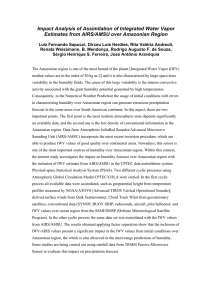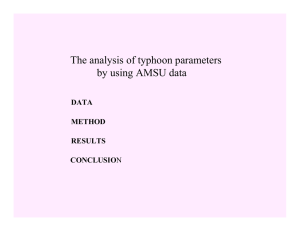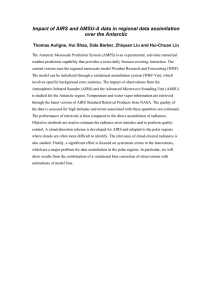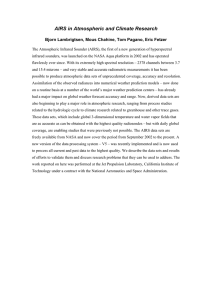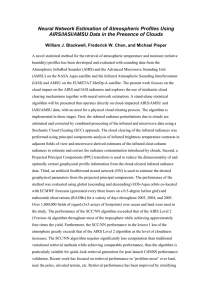THE INCLUSION OF INTEGRATED WATER VAPOR ESTIMATES FROM AIRS/AMSU AND... SENSORS INTO THE CPTEC S DATA ASSIMILATION SYSTEM
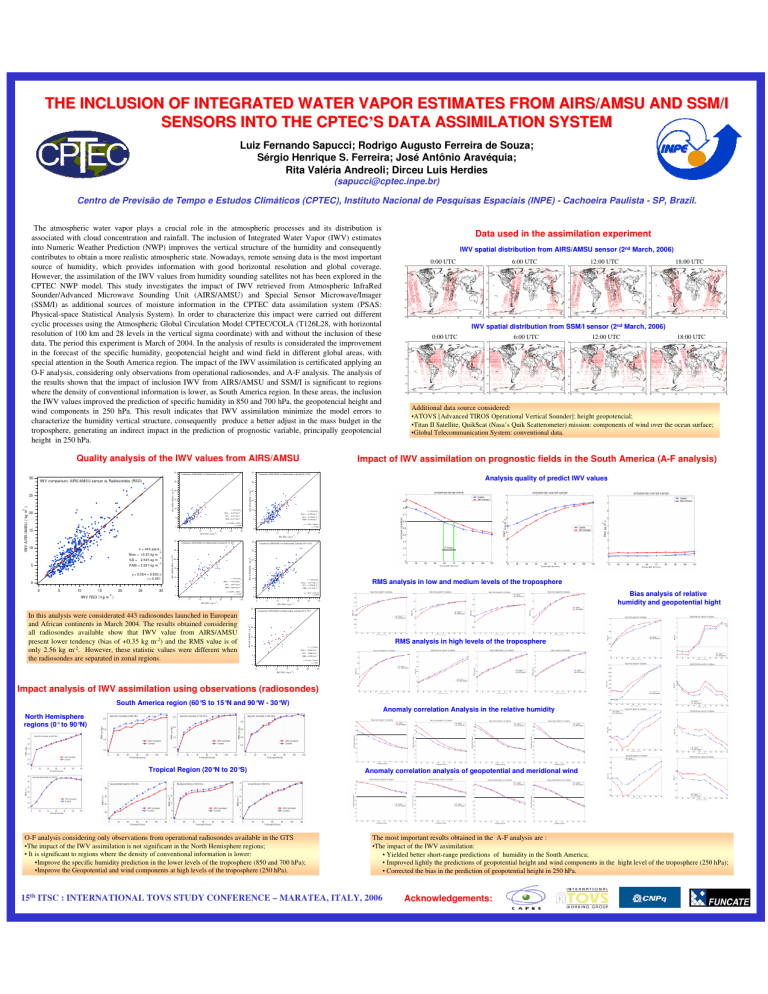
SENSORS INTO THE CPTEC ’ ’ S DATA ASSIMILATION SYSTEM
Luiz Fernando Sapucci; Rodrigo Augusto Ferreira de Souza;
Sérgio Henrique S. Ferreira; José Antônio Aravéquia;
Rita Valéria Andreoli; Dirceu Luis Herdies
(sapucci@cptec.inpe.br)
Centro de Previsão de Tempo e Estudos Climáticos (CPTEC), Instituto Nacional de Pesquisas Espaciais (INPE) - Cachoeira Paulista - SP, Brazil.
The atmospheric water vapor plays a crucial role in the atmospheric processes and its distribution is associated with cloud concentration and rainfall. The inclusion of Integrated Water Vapor (IWV) estimates into Numeric Weather Prediction (NWP) improves the vertical structure of the humidity and consequently contributes to obtain a more realistic atmospheric state. Nowadays, remote sensing data is the most important source of humidity, which provides information with good horizontal resolution and global coverage.
However, the assimilation of the IWV values from humidity sounding satellites not has been explored in the
CPTEC NWP model. This study investigates the impact of IWV retrieved from Atmospheric InfraRed
Sounder/Advanced Microwave Sounding Unit (AIRS/AMSU) and Special Sensor Microwave/Imager
(SSM/I) as additional sources of moisture information in the CPTEC data assimilation system (PSAS:
Physical-space Statistical Analysis System). In order to characterize this impact were carried out different cyclic processes using the Atmospheric Global Circulation Model CPTEC/COLA (T126L28, with horizontal resolution of 100 km and 28 levels in the vertical sigma coordinate) with and without the inclusion of these data. The period this experiment is March of 2004. In the analysis of results is considerated the improvement in the forecast of the specific humidity, geopotencial height and wind field in different global areas, with special attention in the South America region. The impact of the IWV assimilation is certificated applying an
O-F analysis, considering only observations from operational radiosondes, and A-F analysis.
The analysis of the results shown that the impact of inclusion IWV from AIRS/AMSU and SSM/I is significant to regions where the density of conventional information is lower, as South America region. In these areas, the inclusion the IWV values improved the prediction of specific humidity in 850 and 700 hPa, the geopotencial height and wind components in 250 hPa.
This result indicates that IWV assimilation minimize the model errors to characterize the humidity vertical structure, consequently produce a better adjust in the mass budget in the troposphere, generating an indirect impact in the prediction of prognostic variable, principally geopotencial height in 250 hPa.
Quality analysis of the IWV values from AIRS/AMSU
30
IW V comparison: AIRS/AMSU sensor vs Radiosondes (RSO)
25
20
15
10
5
0
0 5 10 15
IW V RSO ( kg m
-2
)
20 n = 443 pairs
.
Bias = +0.35 kg m
-2 y = 0.504 + 0.983 x r = 0.851
25 30
In this analysis were considerated 443 radiosondes launched in European and African continents in March 2004. The results obtained considering all radiosondes available show that IWV value from AIRS/AMSU present lower tendency (bias of +0.35 kg m -2 ) and the RMS value is of only 2.56 kg m -2 . However, these statistic values were different when the radiosondes are separated in zonal regions.
15
10
5
0
0
20
15
30
Comparison AIRS/AMSU vs Radiosondes (Latitude 65° to 75°)
25
25
20
10
5
0
0 5 10 15
IW V RSO ( kg m
-2
)
20 n = 84 pairs
Bias = -0.442 kg m
.
-2
SD = 2.431 kg m
-2
RMS = 2.457 kg m
-2 y = 0.258 + 0.846 x r = 0.785
25 30
30
Comparison AIRS/AMSU vs Radiosondes (Latitude 35° to 45°)
5 10 15
IW V RSO ( kg m
-2
)
20
n = 50 pairs
-2
Bias = +1.444 kg m
SD = 3.607 kg m
-2
.
RMS = 3.852 kg m
-2 y = 3.686 + 0.831 x r = 0.795
25 30
10
5
20
15
0
0
20
15
30
Comparison AIRS/AMSU vs Radiosondes (Latitude 55° to 65°)
25
20
15
10
5
0
0
30
5 10 15
IWV RSO ( kg m
-2
)
20
n = 152 pairs .
Bias = +0.086 kg m
-2
SD = 2.348 kg m
-2
RMS = 2.342 kg m
-2 y = 1.320 + 0.842 x r
= 0.742
25 30
Comparison AIRS/AMSU vs Radiosondes (Latitude 45° to 55°)
25
10
30
5
0
0 5 10 15
IW V RSO ( kg m
-2
)
20
n = 160 pairs .
Bias = +0.817 kg m
-2
SD = 2.496 kg m
-2
RMS = 2.619 kg m
-2 y = 1.667 + 0.916 x r = 0.882
25 30
Comparison AIRS/AMSU vs Radiosondes (Latitude 25° to 35°)
25
5 10 15
IW V RSO ( kg m
-2
)
20 n = 17 pairs
-2
Bias = +3.938 kg m
.
SD = 3.892 kg m
-2
RMS = 5.456 kg m
-2 y = 9.193 + 0.447 x r
= 0.421
25 30
13 hours
Data used in the assimilation experiment
IWV spatial distribution from AIRS/AMSU sensor (2 nd March, 2006)
0:00 UTC 6:00 UTC 12:00 UTC 18:00 UTC
IWV spatial distribution from SSM/I sensor (2 nd March, 2006)
0:00 UTC 6:00 UTC 12:00 UTC 18:00 UTC
Additional data source considered:
•ATOVS [Advanced TIROS Operational Vertical Sounder]: height geopotencial;
•Titan II Satellite, QuikScat (Nasa’s Quik Scatterometer) mission: components of wind over the ocean surface;
•Global Telecommunication System: conventional data.
Impact of IWV assimilation on prognostic fields in the South America (A-F analysis)
Analysis quality of predict IWV values
RMS analysis in low and medium levels of the troposphere
RMS analysis in high levels of the troposphere
Bias analysis of relative
humidity and geopotential hight
Impact analysis of IWV assimilation using observations (radiosondes)
South America region (60°S to 15°N and 90°W - 30°W)
North Hemisphere
regions (0° to 90°N)
Anomaly correlation Analysis in the relative humidity
Tropical Region (20°N to 20°S)
Anomaly correlation analysis of geopotential and meridional wind
O-F analysis considering only observations from operational radiosondes available in the GTS
•The impact of the IWV assimilation is not significant in the North Hemisphere regions;
• It is significant to regions where the density of conventional information is lower:
•Improve the specific humidity prediction in the lower levels of the troposphere (850 and 700 hPa);
•Improve the Geopotential and wind components at high levels of the troposphere (250 hPa).
The most important results obtained in the A-F analysis are :
•The impact of the IWV assimilation:
• Yielded better short-range predictions of humidity in the South America;
• Improved lightly the predictions of geopotential height and wind components in the hight level of the troposphere (250 hPa);
• Corrected the bias in the prediction of geopotential height in 250 hPa.
15 th ITSC : INTERNATIONAL TOVS STUDY CONFERENCE – MARATEA, ITALY, 2006 Acknowledgements:
